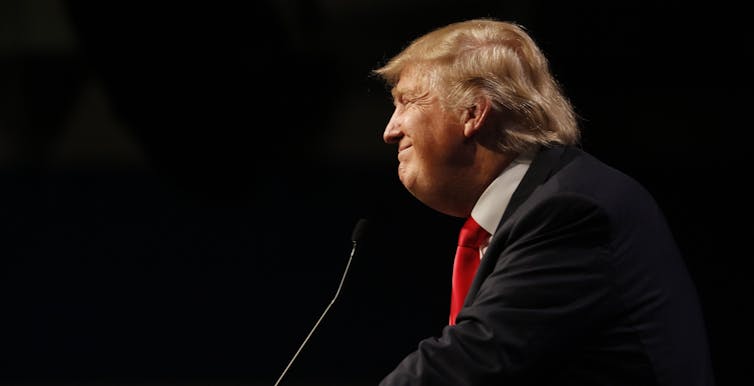
Professor Jackie Harrison, CFOM Chair, writes about the long history of media manipulation and fake news, and the staying power of quality journalism. This piece for The Conversation, published on the World Press Freedom Day 2018, marks also the UNESCO announcement for Jackie Harrison, who has been awarded a prestigious new UNESCO Chair in Media Freedom, Journalism Safety and the Issue of Impunity.
The article, as published on The Conversation:
Fake news has always existed, but quality journalism has a history of survival

Jackie Harrison, University of Sheffield
Donald Trump’s insistence that any challenges to the actions and utterances of the president are “fake news” is particularly chilling because it resembles a tactic used by authoritarian regimes seeking ways to silence independent reporting.
Malaysian authorities looking for new ways to criminalise critical news reporting now include fake news charges. In Egypt – dubbed “one of the world’s biggest prisons for journalists” by the Committee to Protect Journalists – being accused of spreading fake news can come with serious sanctions for national news journalists. In March 2018, it was an accusation used increasingly as a means to intimidate and deter foreign media in the run up to the presidential election.
While attempts to diminish the civil standing of journalism within the US has not led to censorship by bullet (though there are reports of attacks and arrests of journalists, exclusion from press calls and seizure of equipment), they are still destructive in their intention to undermine the crucial playing out of dissent and agreement within the civil sphere. Obstructing independent and dissenting journalism is a serious problem in an era where a growing number of news providers see their audiences as partisans rather than citizens.
Audiences who invest in highly partisan news that disconnects itself from truth telling, objectivity and investigative rigour respond positively to the endless pledges of loyalty by news providers, which in turn generate trust from them. These news providers seek to represent and confirm rather than challenge their audience’s beliefs and values. Such is the diminishment of public discourse and the proliferation of what author of the 2017 study Post Truth, Matthew D’Ancona calls “incommensurable realities”, where “prudent conduct consists in choosing sides rather than evaluating evidence”.
These days the scale and speed of the way highly partisan news and falsehoods circulate is unprecedented. So far the evidence in the USA has suggested that it is mainly pro-Trump supporters that visit fake news sites.
In his new book The People vs Democracy, political theorist Yascha Mounk warns that the populists who have exploited new technology effectively and without constraint have “been willing to say anything to get elected – to lie to obfuscate and to incite hatred”.
Equally ominous are the findings of an MIT study which noted that resistance to bias and fakery requires real effort, simply because there is a huge appetite for news that is fun, accessible, that reinforces prejudices, is easy to consume and is amusing to share. And while “robots accelerated the spread of true and false news at the same rate… false news spreads more than the truth because humans, not robots, are more likely to spread it”. Or as a story in the Atlantic put it:
Falsehoods almost always beat out the truth on Twitter, penetrating further, faster and deeper into the social network than accurate information… [perhaps because] false stories inspired fear, disgust, and surprise… [while] true stories inspired anticipation, sadness, joy, and trust.
Partisan and fake news is nothing if not exciting.
A history of survival
For many it’s beginning to seem as if fake news is more of a threat than ever and that “the bad” seems to be edging ahead – but so far it hasn’t won. Quality journalism still displays “civil resistance” and a history of survival is on its side.
The historical reality is that news providers who try to provide truth-telling news have always done so in a hostile climate. And how toxic it is, is just a matter of degrees. Benign and malign news is unchanging in its co-existence, disagreement and fundamental rivalry.
What remains true then and now is how fraudulent news activities succeed so well in engaging their audiences, being shared and recycled in no small part because they so destructively masquerade as genuine news. Truthful news was just as difficult to verify in the era of the invention of the Gutenberg printing press.
As author Kenan Malik points out, in 1672 Charles II had to issue a proclamation “to restrain the spreading of false news”. In Germany the word “Lügenpresse” (lying press) has been used as a political insult by both right and left since the mid-19th century and has been employed as an anti-democratic slogan and a xenophobic slur.

Dutch National Archives, CC BY-SA
Almost a century later in 1931, Stanley Baldwin (then UK prime minister) said of Lord Beaverbrook and Lord Rothermere, proprietors of the Daily Express and Daily Mail respectively, that their newspapers employed “direct falsehoods, misrepresentation, half-truths, the alteration of the speaker’s meaning by publishing a sentence apart from the context”.
Nevertheless quality journalism has a history of survival. Why? Because the public, according to most audience surveys, persistently value accurate, sincere and objective news – news that they believe displays editorial integrity. And they do so because they conform to a deeply held need for a fair-minded and comprehensive understanding of events. In other words, the public regard quality journalism as a civil necessity.The co-existence in the media of what is regarded as desirable and undesirable is inevitable and inescapable. Journalism that is uncomfortable, truthful, critical and interpretative does so because it has a civil disposition. We need it. And this, as ever, is what is at risk.
Jackie Harrison, Professor of Public Communication, University of Sheffield
This article was originally published on The Conversation. Read the original article.
